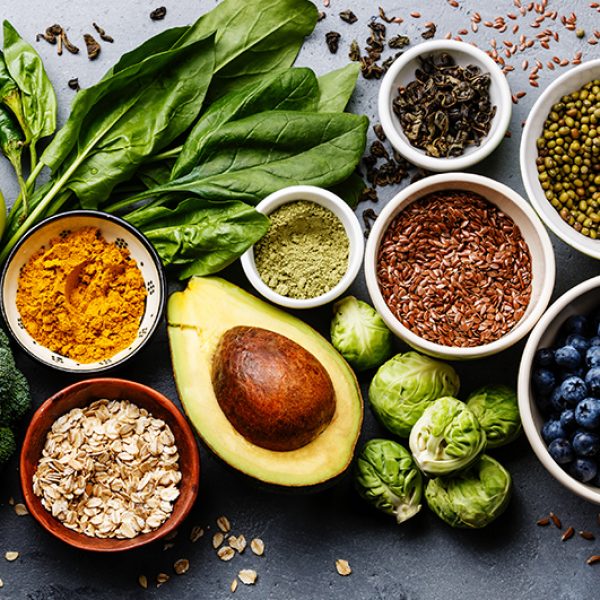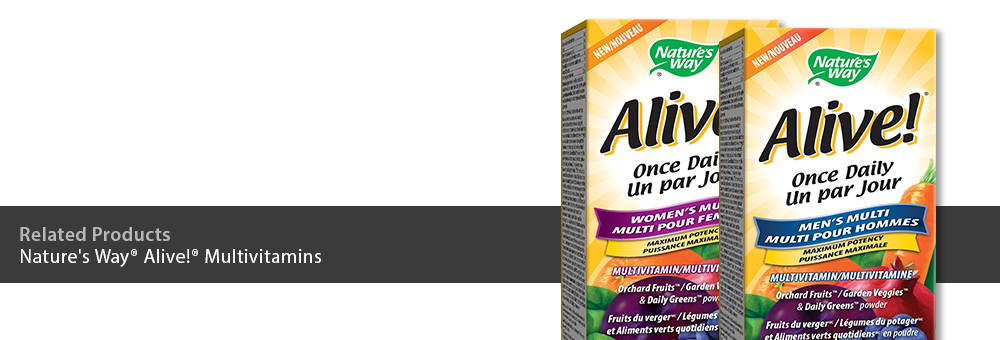

How to add more fruits and veggies to your diet
You’ve probably heard the recommendation to consume at least five servings of vegetables and fruit per day, which is ideal. We all know that sometimes life gets in the way – busy schedules with work, kids, school or other commitments can make healthy meal choices and preparation a challenge for many. In fact many Canadians are not getting enough vitamins and minerals from their diet1. It’s reported that while, 5 in 10 women and 7 in 10 men have energy intakes that exceed their energy needs, many adults still aren’t getting sufficient amounts of certain vitamins and minerals from their diet alone!1.
What are some simple ways to add more nutrients to your diet?
Firstly, from a dietary perspective, it’s important to understand what one serving of fruit or vegetable is. Here are some examples of servings size from Dieticians of Canada2:
• 1 whole medium fruit
• ½ cup (125mL) vegetables or fruit
• 1 cup (250mL) salad greens or leafy vegetables
Here are some simple tips on how to increase those fruit and veggies:
• Breakfast cereal or oatmeal lover? How about adding some fresh or frozen berries to the mix. Or you can try a morning smoothie, with lots of colorful fruit added.
• Snacks: Cut up veggies and fruit can make a great snack, enhanced with some nice nut butter such as almond or peanut to dip them in.
• Be adventurous: Spice up your salad with cut up avocado, pears, apples or perhaps kiwi for an added boost to your usual greens.
• Sprucing up your sandwich: Consider adding sliced veggies such as avocado, tomato, cucumber, cut up peppers or sprouts for example.
• The lettuce wrap: Use lettuce as a bun or wrap instead of a burger bun or tortilla.
There are many ways to improve your diet and nutrient intake. Ideally, we’d all consume a healthy well-balanced diet. However, given that it can be a challenge for some, many people choose to supplement their diet with a multivitamin to help increase their daily nutrient intake.
Key nutrients to look for in a multivitamin include the “sunshine vitamin” or vitamin D and calcium. Did you know that it has been suggested that many Canadians aren’t getting sufficient amounts of these nutrients, with calcium being particularly important for older women?3. Both nutrients play important roles in healthy bone health. There are specific dosage recommendations around these nutrients that can be age dependent3. Consult with a health care provider to determine what options may be appropriate for you.
Alive! Multivitamins include a broad range of vitamins and minerals in both deliciously fun gummy format as well as easy-to-take once daily tablets. All of our Alive! multivitamins include our signature Orchard Fruit & Vegetables Blend and you can also find additional nutrient blends made from whole foods in our tablet formulas.* Alive! multivitamins help in the maintenance of overall good health, support health of skin, bones, and immune function, and help the body metabolize carbohydrates, fats, and proteins. There are formulas for the whole family including specific formulas for women, adults 50 and over, and kid’s.
It’s good to be Alive! Learn more at alivevitamins.ca.
*Note: the blends in our Alive! formulas are not servings of fruit and vegetables and should not be considered a substitute for recommended servings
References:
1. Canada. Health Canada. Do Canadian Adults Meet Their Nutrient Requirements through Food Intake Alone?. Health Canada; 2012. https://www.canada.ca/en/health-canada/services/food-nutrition/food-nutrition-surveillance/health-nutrition-surveys/canadian-community-health-survey-cchs/canadian-adults-meet-their-nutrient-requirements-through-food-intake-alone-health-canada-2012.html. Accessed February 27, 2018.
2. Dieticians of Canada. What is the best way to get the most nutrition from vegetables and fruit? https://www.dietitians.ca/your-health/nutrition-a-z/vegetarian-diets/best-way-to-get-most-nutrition-from-vegetables-and.aspx. Published 2017.
3. Health Canada. Vitamin D and Calcium: Updated Dietary Reference Intakes. website. https://www.canada.ca/en/health-canada/services/food-nutrition/healthy-eating/vitamins-minerals/vitamin-calcium-updated-dietary-reference-intakes-nutrition.html#a9%0A. Published 2012.

